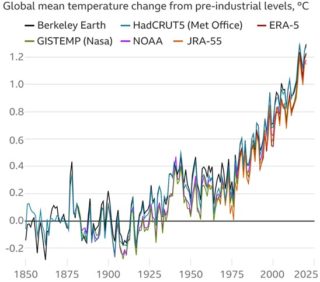-
2011-2020 declared warmest decade on record
Date posted:
-
-
-
Post Author
Philip SharmanIFRF Director
-
-
![]()
The world’s leading global meteorological agencies may not be in exact agreement on which year was the hottest on record – a 2016, 2019 or 2020 – but what they are all agreed on is that the warmest six years have all occurred since 2015, and that the 10 years from 2011 to 2020 was the warmest decade on record.
On 8th January, the Copernicus Climate Change Service (C3S) revealed that, globally, 2020 was tied with the previous warmest year, 2016, making it the sixth in a series of exceptionally warm years starting in 2015. C3S also announced that 2011-2020 was the warmest decade recorded. Meanwhile, Europe saw its warmest year on record, 0.4°C warmer than 2019, which was previously the warmest year. Together with the Copernicus Atmosphere Monitoring Service (CAMS), C3S also reports that carbon dioxide concentrations in the atmosphere have continued to rise at a rate of approximately 2.3ppm/year in 2020, reaching a maximum of 413ppm during May 2020. Both C3S and CAMS are implemented by the European Centre for Medium-Range Weather Forecasts on behalf of the European Commission (with funding by the European Union).
Six days later, reports from other key agencies around the world showed some minor dissent from this view, but all agreed that 2020 is in the top three. NASA agreed with C3S’ ranking, declaring that 2020 was in a statistical dead-heat (if you will excuse the pun) with 2016. The US National Oceanic and Atmospheric Administration (NOAA) and the UK Met Office both ranked 2020 second, slightly behind 2016, while the Japan Meteorological Agency (JMO) placed 2020 in third place behind both 2016 and 2019. However, the differences between the datasets are “indistinguishably small” and are all “within the margin of error”, says the World Meteorological Organization (WMO), which consolidates the information from the key datasets.
![]()
Despite the naturally occurring climate cooling phenomenon, La Niña, putting a brake on the heat at the very end of the year, the average global temperature in 2020 was about 14.9°C, 1.2°C (±0.1°C) above the pre-industrial (1850-1900) level.
Commenting on the WMO’s announcement, United Nations Secretary-General António Guterres stated “The confirmation… that 2020 was one of the warmest years on record is yet another stark reminder of the relentless pace of climate change, which is destroying lives and livelihoods across our planet. Today, we are at 1.2 degrees of warming and already witnessing unprecedented weather extremes in every region and on every continent. We are headed for a catastrophic temperature rise of 3 to 5 degrees Celsius this century. Making peace with nature is the defining task of the 21st century. It must be the top priority for everyone, everywhere.”
WMO Secretary-General Professor Petteri Taalas said “The exceptional heat of 2020 is despite a La Niña event, which has a temporary cooling effect. It is remarkable that temperatures in 2020 were virtually on a par with 2016, when we saw one of the strongest El Niño warming events on record. This is a clear indication that the global signal from human-induced climate change is now as powerful as the force of nature.”
The La Niña event, which began in late 2020, is expected to continue into early to mid-2021. The effects of La Niña and El Niño events on average global temperature are typically strongest in the second year of the event, and the extent to which the continued cooling effects of La Niña in 2021 may temporarily diminish the overall long-term warming trend during this coming year remains to be seen.
The latest temperature figures will be incorporated into the final WMO report on the ‘State of the Climate in 2020’ due to be issued in March 2021. This report will include information on all leading climate indicators and selected climate impacts, and updates a provisional report issued in December 2020.
The Paris Agreement seeks to hold the increase in the global average temperature to well below 2°C above the pre-industrial level, while pursuing efforts to limit the temperature increase to 1.5°C above this level. At 1.2°C above the pre-industrial level, the global average temperature in 2020 is already approaching the lower limit of temperature increase the Paris Agreement seeks to avert. There is at least a one-in-five chance of the average global temperature temporarily exceeding 1.5°C by 2024, according to WMO’s Global Annual to Decadal Climate Update, led by the UK’s Met Office.
The Met Office annual global temperature forecast for 2021 suggests that this year will once again enter the series of the Earth’s hottest years, despite being influenced by the temporary cooling of La Niña, the effects of which are typically strongest in the second year of the event.


